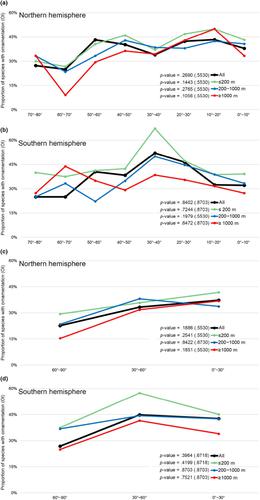当前位置:
X-MOL 学术
›
Ecol. Evol.
›
论文详情
Our official English website, www.x-mol.net, welcomes your
feedback! (Note: you will need to create a separate account there.)
Variation of shell ornamentation with latitude and water depth—A case study using living brachiopods
Ecology and Evolution ( IF 2.3 ) Pub Date : 2023-04-21 , DOI: 10.1002/ece3.10006 Facheng Ye 1 , Maria Aleksandra Bitner 2 , Guang Rong Shi 1
Ecology and Evolution ( IF 2.3 ) Pub Date : 2023-04-21 , DOI: 10.1002/ece3.10006 Facheng Ye 1 , Maria Aleksandra Bitner 2 , Guang Rong Shi 1
Affiliation

|
As a potential anti-predatory defensive structure, the shell ornamentation of marine calcifiers is usually used to understand the macro coevolution of the interactions between predators and preys. Marine calcifiers' shell ornamentation complexity is generally believed to vary negatively with latitude and water depth. In this paper, we explored the association between shell ornamentation and latitude/bathymetry using the latest global database of living brachiopods. We found that (1) ~59% of living brachiopods species are characterized by smooth shells and that (2) there is no statistically significant linear trend, either positive or negative, between the ornamentation index and latitudes nor with water depths. Both findings are puzzling for living brachiopods as they are sharply contrasted to the patterns of fossil brachiopods whereby the latter, especially Paleozoic brachiopods, are known to exhibit (1) a much greater ornamentation diversity and (2) (at least for the geological periods that have been studied) a linear latitudinal gradient of ornamentation complexity existed. The reasons why living brachiopods have such a high proportion of smooth or weakly ornamented shells and fail to demonstrate an unequivocal linear latitudinal ornamentation gradient were explored and are linked to a multitude of potential factors rather than uniquely only to the predation pressure. Among these, the most plausible factor seems to be the cryptic (refuge-type) habitats (e.g., deep waters, cold polar regions, and submarine rock caves) that living brachiopods have been adapted to due to their low metabolism, where predation pressure is low, allowing brachiopods to enact the predator avoidance strategy rather than having to manufacture robust shell ornamentation to survive in an otherwise highly engaged predator–prey global marine ecosystem.
中文翻译:

贝壳纹饰随纬度和水深的变化——以现存腕足动物为例
作为一种潜在的反捕食防御结构,海洋钙化者的壳纹饰通常被用来理解捕食者与猎物相互作用的宏观协同进化。人们普遍认为海洋钙化鱼的壳纹饰复杂性随纬度和水深呈负变化。在本文中,我们使用最新的全球现存腕足动物数据库探索了贝壳装饰与纬度/测深之间的关联。我们发现 (1) 约 59% 的现存腕足动物物种的特征是外壳光滑,并且 (2) 装饰指数与纬度和水深之间没有统计上显着的线性趋势,无论是正的还是负的。这两个发现对于现存的腕足动物来说都是令人费解的,因为它们与化石腕足动物的模式形成鲜明对比,后者,尤其是古生代腕足动物,已知表现出(1)更大的装饰多样性和(2)(至少在地质时期已经研究过)存在装饰复杂性的线性纬度梯度。对现存腕足类动物具有如此高比例的光滑或装饰性较弱的壳并且未能表现出明确的线性纬度装饰梯度的原因进行了探索,并与多种潜在因素相关联,而不仅仅是捕食压力。其中,最合理的因素似乎是隐蔽(避难所类型)的栖息地(例如,深水、寒冷的极地地区、
更新日期:2023-04-22
中文翻译:

贝壳纹饰随纬度和水深的变化——以现存腕足动物为例
作为一种潜在的反捕食防御结构,海洋钙化者的壳纹饰通常被用来理解捕食者与猎物相互作用的宏观协同进化。人们普遍认为海洋钙化鱼的壳纹饰复杂性随纬度和水深呈负变化。在本文中,我们使用最新的全球现存腕足动物数据库探索了贝壳装饰与纬度/测深之间的关联。我们发现 (1) 约 59% 的现存腕足动物物种的特征是外壳光滑,并且 (2) 装饰指数与纬度和水深之间没有统计上显着的线性趋势,无论是正的还是负的。这两个发现对于现存的腕足动物来说都是令人费解的,因为它们与化石腕足动物的模式形成鲜明对比,后者,尤其是古生代腕足动物,已知表现出(1)更大的装饰多样性和(2)(至少在地质时期已经研究过)存在装饰复杂性的线性纬度梯度。对现存腕足类动物具有如此高比例的光滑或装饰性较弱的壳并且未能表现出明确的线性纬度装饰梯度的原因进行了探索,并与多种潜在因素相关联,而不仅仅是捕食压力。其中,最合理的因素似乎是隐蔽(避难所类型)的栖息地(例如,深水、寒冷的极地地区、





















































 京公网安备 11010802027423号
京公网安备 11010802027423号